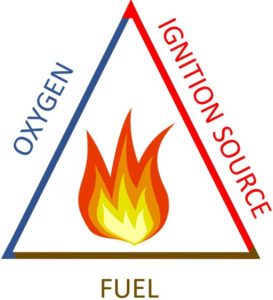Prepared in collaboration with Kara Steshetz and Marina Miletic
Introduction
The purpose of this tutorial is to illustrate the components necessary for the ignition of a fire and to identify ways to prevent fires. The fire triangle, also referred to as the combustion triangle, is a visual representation of the three essential components needed for the ignition of a fire. Each side of the triangle represents a different component.
The Three Components of the Fire Triangle

Oxygen
An oxidizing agent is present in any combustion reaction and reacts with the fuel in an exothermic reaction. The most common oxidizing agent is oxygen because of its abundance in air.
Fuel
The fuel of the fire is any material that can burn. This can be any combustible material, like wood, paper, flammable liquids or gases, rubber, or fabrics. The more fuel, the longer the fire can burn and spread.
A fuel usually needs to be “primed”, or at a minimum temperature, before it can ignite. Flammable vapor mixtures occur at, or above, the flash point temperature of the liquid. The flash point is the temperature at which a vapor-air mixture above a liquid is capable of sustaining combustion after ignition from an energy source. A fine droplet mist can be flammable below the flash point of the liquid. Flammable gas mixtures can form at any temperature.
Ignition Source
An ignition source is needed to preheat the fuel and keep the fire alight. About 98% of all ignitions come from open flames, hot surfaces, hot gases, sparks from mechanical or electrical equipment, static electricity, and chemical reactions. Other ignitions sources can include lightning strike, electromagnetic radiation, or stray electrical currents.
Other Important Flammability Concepts
Flash Point
Temperature at which a vapor-air mixture above a liquid is capable of sustaining combustion after ignition from an energy source.
Flammability Limit
Vapor in mixtures will only ignite and burn over a well-specified range of compositions.
- Lower Flammability Limit (LFL): Below the LFL the mixture will not burn as it is below the lower flammability limit, i.e., the mixture is too lean (i.e., insufficient fuel) for combustion.
- Upper Flammability Limit (UFL): Above the UFL the mixture will not be combustible as the composition is too rich (e.g., insufficient oxygen).
Preventing Fires
To stop a fire only one of the three components needs to be removed. There are many ways to reduce the risk of a fire, and a few are listed below:
- Eliminate ignition sources:
- Ground metal parts to reduce static electricity from forming.
- Do not use electrical equipment near flammable liquids and gases.
- Do not weld on or near containers that have been or are containing flammable substances.
- Reduce quantity of fuel:
- Do not store large quantities of flammable substances near each other.
- Limit the amount of a flammable substance being stored.
- Limit the oxidant concentration:
- Store a compatible fire extinguisher near the flammable substances.
- Reduce the concentration of the flammable material to be out of its flammability limits by combining it with nitrogen gas.
Protecting people and facilities from fire damage
- Use explosion-resistant vessels when designing a chemical process.
- Ensure adequate pressure relief devices are in place.
- Isolate high temperature equipment (which can become an ignition source) from flammable materials.
- Install explosion-suppression devices.
Knowledge Check
There is a Fire Triangle knowledge check quiz available.
References
- County Fire Protection. Understanding Fire: The Fire Triangle. https://county-fire.com/understanding-fire-the-fire-triangle
